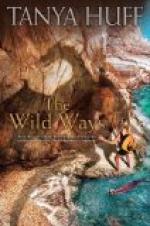But, all the same, Blackie was not pleased. He was worked off his feet providing rations for three ugly youngsters in a magnificently designed and exquisitely worked and interwoven edifice, interlined with rigid cement of mud, which we, in an off-hand manner, simply dismiss as “A nest.” The young were his children; they might have been white-feathered angels with golden wings, by the value he put on them. The thrush episode was only a portent, and not the first. He had no trouble with the other feathered people he tolerated on his beat.
Blackie went straight to the lawn. (Jet and orange against deep green was the picture.)
Now, if you and I had searched that dry lawn with magnifying-glasses, in the heat of the sun, there and then, we should not have found a single worm, not the hint or the ghost of one; yet that bird took three long, low hops, made some quick motion with his beak—I swear it never seemed to touch the ground, even, let alone dig—–executed a kind of jump in the air—some say he used his legs in the air—and there he was with a great, big, writhing horror of a worm as big as a snake (some snakes).
Thrushes bang their worms about to make them see sense and give in; they do it many times. Blackie banged his giant only a little once or twice, and then not savagely, like a thrush. Also, again, he may or may not have used his feet. Moreover, he gave up two intervals to surveying the world against any likely or unlikely stalking death. Yet that worm shut up meekly in most unworm-like fashion, and Blackie cut it up into pieces. The whole operation took nicely under sixty seconds.
Blackie gave no immediate explanation why he had reduced his worm to sections. It did not seem usual. Instead, he eyed the hedge, eyed the sky, eyed the surroundings. Nothing seemed immediately threatening, and he hopped straight away about three yards, where instantly, he conjured another and a smaller worm out of nowhere. With this unfortunate horror he hopped back to the unnice scene of the first worm’s decease, and carved that second worm up in like manner. Then he peeked up all the sections of both worms, packing them into his beak somehow, and flew off. And the robin who was watching him didn’t even trouble to fly down to the spot and see if he had left a joint behind. He knew his blackbird, it seemed.
Blackie flew away to his nest, but not to a nest in a hedge. To dwell in a hedge was a rule of his clan, but the devil a rule did he obey. Nests in hedges for other blackbirds, perhaps. He, or his wife, had different notions. Wherefore flew he away out into the grass field behind the garden. Men had been making excavations there, for what mad man-purpose troubled him not—digging a drain or something. No matter.
Into the excavation he slipped—–very, very secretly, so that nobody could have seen him go there—and down to the far end, where, twelve feet below the surface, on a ledge of wood, where the sides were shored with timber, his mate had her nest. Here he delivered over his carved joints to the three ugly creatures which he knew as his children and thought the world of, and appeared next flying low and quickly back to the garden. That is to say, he had contrived to slip from the nest so secretly that that was the first time he showed.




